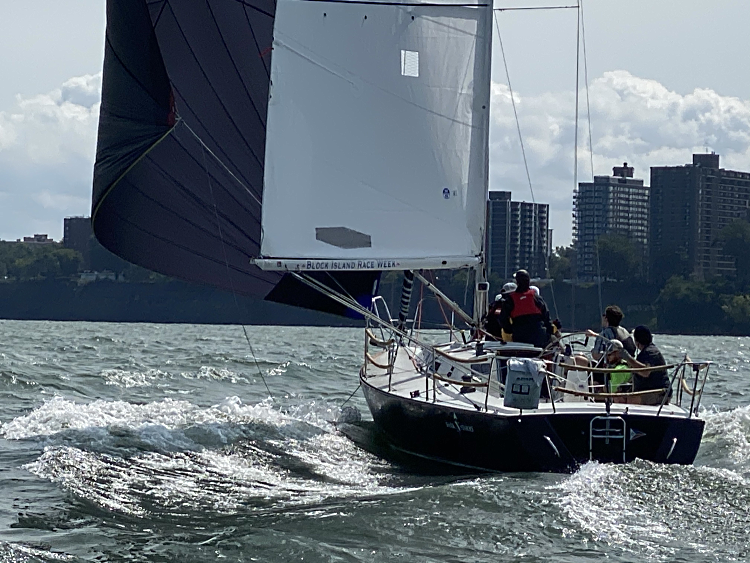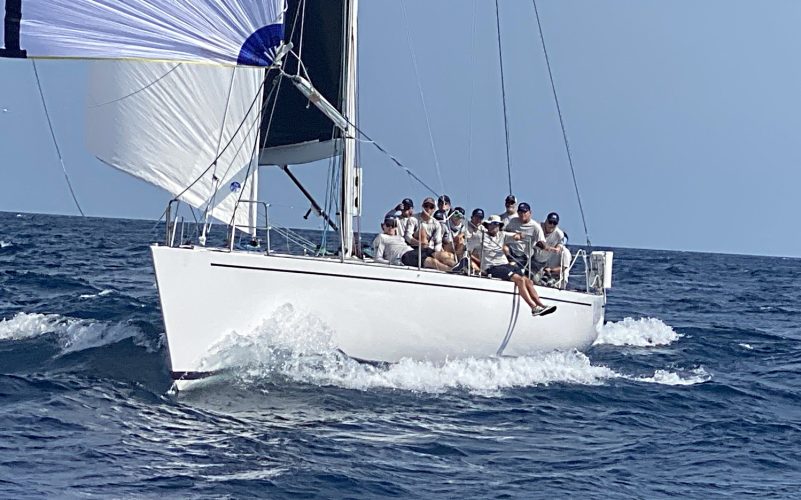In September 2019, British sailor Jeanne Socrates set the record for the oldest nonstop circumnavigator of any gender. She completed this trip in under a year, and set the record at the tender age of 77. Doing so, she broke the record for oldest nonstop female circumnavigator that she set in 2013.
And less than a year later, 81-year-old Bill Hatfield broke her record.
While neither of these offshore sailors started sailing after sixty, Socrates didn’t start sailing until she was forty-eight. She wasn’t exactly a child prodigy, and you don’t need skills like Socrates to get out on the water and have some fun in the fresh air.
So is sixty too old to start sailing?
In a word? Emphatically, NO!
Sailing as a Lifetime Sport
Sailing is a life sport – it’s one of those activities that you can learn at any time and do your whole life. It can be physically demanding, but you can also take it at your own pace. You can stay the same thing about skiing, golf, tennis, swimming or any other sport people can do in their 70s, 80s and beyond. If you can pace yourself and enjoy it safely, you can learn it at any age.
Like any skill sport, starting earlier in life will always give you an edge. But that doesn’t matter with sailing any more than anything else you take up for enjoyment and relaxation. You can learn the sport, and it’s one that will keep you physically and mentally sharper.
There are many ways to sail, from racing dinghies to cruising keelboats, and you can sail any way that suits you. What’s important is how to learn and how to get on the water, and what you can do to prepare yourself to make it more fun. The key is to walk before you try to run, and take your time to learn the fundamentals so you sail safely and have fun.
 Options for Learning
Options for Learning
Many waterfront communities have community sailing centers or sailing schools where you can take lessons. Many of them will teach you on small boats and dinghies, but you may prefer a keelboat if you’re not comfortable with the small boat’s physical demands.
If sailing schools offer keelboat lessons, that’s a great place to start. Sailing with friends who have boats is another. Almost every sailor is happy to bring new sailors out and show them the sport they’re so passionate about.
Boat share and fractional sailing clubs usually offer lessons, but buying into these right away may not be the best way for a rank beginner to learn. With a few lessons and some time on the water, they can an excellent alternative to buying your own boat to get some more sea time.
How You Can Sail
There are a lot of ways to sail, and how you choose to learn depends on your preferences and your physical condition. There’s nothing that says you can’t take up more than one type of sailing, or that you can’t use the same boat for different activities. Your capabilities and preferences set the choices.
Dinghies and Small Boats
Some dinghies are small and physical, but there are many small boats that are quite comfortable and forgiving. You can have a great time day sailing small boats without a big dollar commitment to ownership. Most learning programs have dinghies for two or three people, and the smaller, more responsive boats give great feedback for learning. And if you like it, buying a small boat isn’t such a stretch.
You may get a little wet and a little sore, but small boats are loads of fun for an afternoon or day sail.
Dinghy Racing
Many yacht clubs and sailing associations sponsor dinghy racing. From physical boats like the Laser to larger two and three person boats, you’ll find weekend and weeknight racing anywhere people sail.
Dinghy racing isn’t just for the young. International Laser Class Association has a “Masters” division with a minimum age of thirty, and class breaks for age groups all the way up past seventy-five. Master class racers sail in every local Laser fleet.
Laser and other small dinghy racing is physical, wet, and close to the water. It’s not for everyone, but it’s something you can learn late and do well into your 70s. And it keeps you in shape.
 Keelboat Cruising
Keelboat Cruising
Your vision of sailing may be a day out on the bay or a weekend anchored out at an island. Those are very popular ways to enjoy sailing, and you won’t need a wetsuit. You’ll need access to a boat, of course, and some gear for safety and comfort. But the physical demands of sailing a keelboat are quite reasonable.
And going some place under sail just using your own skill and cleverness, well that’s just fun.
Keelboat Racing
Any boat you can sail can be raced, though some take it more seriously than others. Racing is a fantastic way to build skills; you will learn better sailing to stay competitive. Racing runs from low-key jib and main club series to major regattas, but most beginners in their sixties will start in the local weeknight “beer can” or club series.
Some of the wiliest sailors on the weeknight race course are the experienced senior sailors in the jib and main fleet!
Helpful Gear
No matter how you’re getting on the water, a few key pieces of equipment will help you be more comfortable and safe. There’s no need to rush out and gear up with a full set of foul weather gear and an expensive personal safety equipment. You won’t need most of that until you venture past day sailing, and even then you’ll need little of it unless you go offshore and start crossing big stretches of water.
Personal Equipment
Every keelboat sailor should own a few things:
- Nonslip shoes with a light, non-marking sole. Look specifically for sailing tread patterns, which work better on wet decks than sneakers.
- Sailing gloves. While they can protect you from chafe and rope burn, their major purpose is better grip on lines.
- Lifejacket/Personal Flotation Device. Every boat will have a PFD for everyone, but a cheap collar-style lifejacket isn’t comfortable for long. You’ll want something that fits you well, doesn’t slide around, and is adjustable and compact.
- Sailing books. While there’s no substitute for a line, wheel, or tiller in your hand, a lot of what you need to know about sailing you can get from reading. Before you head out you can learn the theory, and when you come back you can figure out how to do it better.
If you’re heading down the racing path in dinghies, you’ll need more. But sailing drier boats, you don’t need so much to get started.
Clothing and What to Wear
Beyond the shoes and gloves, the right clothing and personal protection makes a difference in comfort. Even on a sunny warm day, sailing upwind can be cool and breezy, and you still get splash and spray in some conditions.
A good sailing jacket can make all the difference between a comfortable dry day and cold misery. At a minimum, you want a decent water repellent wind breaker for day sailing in the summer. As you expand the conditions and seasons you sail in, you’ll need better protection.
Avoid cotton clothing, instead look for quick-drying synthetics. Better still look for synthetics with SPF sun protection ratings, though anything which doesn’t stay wet and stick to your skin is better than a cotton. For cool weather sailing, wool is excellent because it still insulates if it gets wet.
For sun protection, consider a full-brimmed hat like a Tilley or other sailing hat with a strap. It will keep the sun off your face, but also off the back of your neck. If you prefer a baseball cap, get a clip to secure it to your shirt so it doesn’t blow off.
Polarized sunglasses will save eye fatigue and help you spot wind and surface patterns on the water. If they’re expensive or prescription, make sure you’ve got a glass holder around your neck so you don’t lose them over board.
Sunscreen is also a must. The water is very reflective, and sailors burn fast if they don’t cover up. So don’t take any chances on a nasty burn or increase your chances for skin cancer. An oil-free sunscreen keeps your hands dry and won’t feel slippery or greasy.
Getting Started
If you want to sail and you’re worried about your age, the best thing to do is just get out there and try it out. If you’ve got a friend with a boat, get a ride. Visit a community sailing center or school.
Sailing is a sport for all ages, and almost anyone who loves the sport will help you learn.

